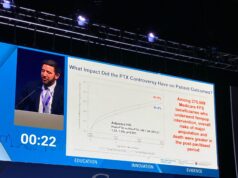
By Thomas Zeller
The Katsanos et al meta-analysis reports an increased risk of mortality beyond one year across randomised studies of paclitaxel-coated balloons (DCB) and paclitaxel-eluting stents (DES). These observations are of great interest to the vascular specialist community. Even if these results are indeed alarming, as they suggest a paclitaxel-related excess mortality for patients with femoropopliteal artery disease, these findings must be interpreted with caution before the use of DCB and DES—which are the most effective interventional tools to date for femoropopliteal artery revascularisation—is discouraged.
I am concerned with the conclusion that there is an association between all-cause mortality and paclitaxel with no clear causal explanation of a pathophysiological mechanism of action. The authors spend no time exploring other potential hypotheses for the observed trends and the lack of patient-level data is a clear limitation to being able to draw these conclusions. As one of the investigators in several of the studies cited here—in particular of those with five-year follow-up (THUNDER, IN.PACT SFA randomised controlled trial, ZILVER PTX randomised controlled trial)—it is important to note that the observed trend is not new. In fact, we published two- and three-year results showing a statistically significant frequency of all-cause mortality between DCB and plain balloon agioplasty arms of the IN.PACT SFA study. We have subsequently presented on the four- and five-year data, showing no significant difference in mortality. Events in the trial were reviewed by an independent Clinical Events Committee and none were related to the device, or paclitaxel.
Clinical pharmacokinetic data of paclitaxel-releasing DCB and DES demonstrated that detectable systemic exposure does not persist longer than a month before drug elimination drives blood concentrations below the level of detection (usually within a couple of weeks). In such circumstances, it is difficult to conceive of a scenario where such drug levels could produce severe and significant systemic events.
For readers not versed in statistical models and meta-analysis, the authors do not take the time to explain the assumptions that went into the analysis nor the assumptions for the equation. For example, the equation suggests that the input dose of paclitaxel persists at the same rate over time. This is clearly inaccurate, as the authors stated paclitaxel is detectable only for weeks to months.
If the authors looked at randomised controlled trials of non-drug eluting endovascular devices trials, they would find a similar trend in mortality, showing an increased mortality rate in the active comparator arm of these trials.
Importantly, the mortality rates observed in the paclitaxel device trials are consistent with rates reported in epidemiological studies of peripheral arterial disease patients and in populations outside the clinical trial setting. Therefore, I question the leap to an association between paclitaxel and mortality. This likely reflects the natural progression of disease in these patients, who are known to present with concomitant comorbidities.
Finally, the authors do not differentiate between continents (America, Europe and Asia). Local differences in clinical follow-up programmes may also drive differences in all-cause mortality.
This meta-analysis highlights the need for additional long-term and patient-level data. Without this, the Katsanos et al conclusion is premature.
Thomas Zeller, Universitaets-Herzzentrum, Bad Krozingen, Germany, is also a member of the Charing Cross Symposium Peripheral Arterial Executive Board.









